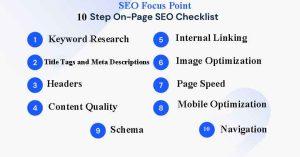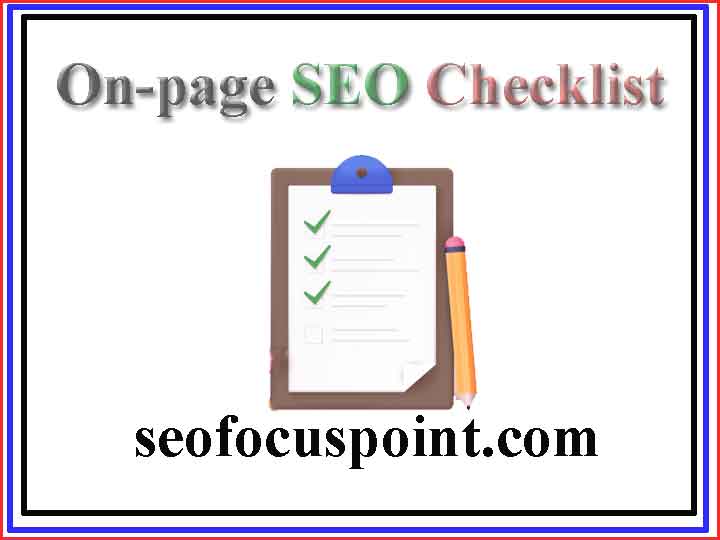In this article we will Discuss about 10 On-page SEO Checklist you must have to to Optimize your website & Rank to of SERP. If you read this article from today you will be on page SEO Expert. Lets start to our topics.
Table of Contents
Table of Contents
What is On-page SEO Checklist?
On-page SEO checklist is a list of best practices for optimizing a website’s individual web pages to improve its search engine rankings and visibility. The checklist includes various factors that impact a page’s ranking, such as keyword research, content quality, title tags, meta descriptions, header tags, internal linking, image optimization, page speed, mobile optimization, schema markup, and navigation. By following these on-page SEO best practices, website owners can improve the relevance, usability, and performance of their web pages, making them more accessible to search engines and easier for users to find and navigate.
On-page SEO Checklist
Here is the 10 on-page SEO checklist, These are the indispensable part of seo. These checklist is the heart of SEO.

- Keyword Research: Identify the Right Words Before creating any content, you should perform keyword research to identify the most relevant and popular keywords that relate to your topic. This will help you create content that resonates with your audience and helps you rank higher in search engine results pages (SERPs).Here’s an example of how to conduct keyword research:
- Brainstorming: Start by brainstorming a list of keywords and phrases related to your topic. Use tools like Google Suggest, Answer the Public, and Quora to generate ideas.
- Keyword Analysis: Use a keyword research tool such as Google Keyword Planner, Ahrefs, SEMrush, or Moz Keyword Explorer to analyze the search volume, competition, and relevance of your initial list of keywords. Look for keywords with high search volume and low competition.
- Long-Tail Keywords: Consider adding long-tail keywords, which are more specific and targeted than broad keywords. They often have lower search volume but higher conversion rates.
- Keyword Grouping: Organize your keywords into groups based on their relevance and intent. This will help you create content that targets specific keywords and phrases.
- Competitive Analysis: Analyze the keywords and phrases your competitors are using to rank for your target topic. Look for opportunities to target keywords that they may have overlooked or ignored.
- Refine and Optimize: Refine your list of keywords based on the search volume, competition, and relevance metrics. Optimize your website’s content and structure around the targeted keywords to improve your website’s ranking and visibility.
By conducting thorough keyword research, you can identify the most relevant and valuable keywords for your website and optimize your content to target them effectively, driving more traffic and higher search engine rankings.
- Title Tags and Meta Descriptions: Make them Compelling Title tags and meta descriptions are essential elements of on-page SEO. They show up in the SERPs and play a significant role in determining whether people will click through to your website. Make sure to include your target keyword in the title tag and meta description, while making them compelling and attention-grabbing.
Here’s an example of how to optimize title tags and meta descriptions:
Title Tag Example: Title tags should be around 60 characters or less and include your target keyword.
Example: “Best Pizza in New York | Joe’s Pizza NYC”
Meta Description Example: Meta descriptions should be around 155 characters or less and include a brief summary of the content on the page, including the target keyword.
Example: “Looking for the best pizza in New York City? Look no further than Joe’s Pizza NYC. Our authentic pizza is made with fresh ingredients and cooked to perfection. Come taste the difference today!”
In this example, the title tag includes the target keyword “Best Pizza in New York” and the brand name “Joe’s Pizza NYC.” The meta description provides a brief summary of what the page is about and includes the target keyword and a call-to-action to entice users to click through to the website.
By optimizing title tags and meta descriptions, website owners can improve the relevance and visibility of their web pages in search engine results, driving more traffic to their website.
- Headers: Structure Your Content Headers (H1, H2, H3, etc.) help structure your content and make it easier for readers to navigate your pages. They also help search engines understand the hierarchy and structure of your content. Use your target keyword in at least one header tag, and ensure that your headers are informative and relevant.Headers, also known as heading tags or H-tags, are important for SEO because they help to structure and organize the content on a web page. Here are a few reasons why headers are important for SEO:
- Accessibility: Headers help to make your content more accessible to users, especially those with disabilities who use screen readers. By using headers to structure your content, you make it easier for users to understand the hierarchy of information on the page and navigate to the sections that interest them.
- Keyword Optimization: Headers provide an opportunity to include your target keywords and phrases, which can help to improve your page’s relevance and ranking in search results. Search engines place more weight on keywords that appear in headers than in regular body text.
- Readability: Headers help to break up the content into sections and make it easier to read, especially on longer pages. Users are more likely to stay engaged with your content if it’s well-organized and easy to scan.
- User Experience: By using headers to structure your content, you provide a better user experience for your visitors, making it easier for them to find the information they’re looking for and navigate your site. This can help to improve user engagement, reduce bounce rates, and increase conversions.
Overall, headers are an important on-page SEO element that can help to improve the accessibility, readability, relevance, and user experience of your web pages, leading to better search engine rankings and more traffic to your site.
- Content Quality: Engage and Inform High-quality content is the cornerstone of on-page SEO. Your content should be engaging, informative, and provide value to your audience. Ensure that it satisfies user intent and helps solve their problems.High-quality content is essential for SEO, as it can help to drive more traffic to your website, engage your audience, and establish your brand as a thought leader in your industry. Here are some key characteristics of high-quality content:
- Relevant and valuable: High-quality content should be relevant to your target audience and provide value to them in some way. This could include educational information, helpful tips, or entertaining stories that resonate with your readers.
- Well-researched and accurate: High-quality content should be well-researched and based on accurate information. This can help to establish your credibility as an authority in your industry and build trust with your readers.
- Engaging and easy to read: High-quality content should be engaging and easy to read, with a clear structure, logical flow, and appropriate use of headings, subheadings, and bullet points. This can help to keep your readers engaged and make your content more shareable.
- Original and unique: High-quality content should be original and unique, with a fresh perspective or new angle on a topic. Avoid simply regurgitating information that’s already available online, and instead aim to add value by providing something new and valuable to your readers.
- Optimized for SEO: High-quality content should also be optimized for SEO, with relevant keywords, meta tags, and other on-page elements that can help to improve your search engine rankings and visibility.
Overall, high-quality content is an essential part of any successful SEO strategy. By creating content that’s relevant, valuable, accurate, engaging, original, and optimized for SEO, you can improve your search engine rankings, drive more traffic to your website, and establish your brand as a thought leader in your industry.
- Internal Linking: Link Your Content Internal linking helps search engines understand the relationship between different pages on your website. It also helps users navigate your site more easily. Ensure that your internal links are relevant and useful to your audience. Suppose, Our Article id about On-page SEO Checklist.We have another article Difference between on page SEO and off page SEO
I have already putted link other resources of my website to this article. - Image Optimization: Describe your Images because Images are an essential part of any website, and optimizing them is crucial for on-page SEO. Include descriptive alt tags that describe the image using relevant keywords, and ensure that your images are compressed and optimized for page speed. Search engine can not see Image like human rather it try to understand Image by your given Descriptions and ALT Tag. Image Optimization Major Impotent element of On-page SEO Checklist.
- Page Speed: Optimize Your Site Page speed is a critical factor in On-page SEO Checklist. Optimize your site by compressing files, minimizing code, and ensuring that your images are optimized for speed. This will improve user experience and help your site rank higher in the SERPs.To check Page Speed, you can use free tool provided by google, PageSpeed Insights
We can increase website speed by followings way :- Optimize images: Images can significantly slow down your website, so it’s important to optimize them for the web. This can include compressing images to reduce their file size, using the appropriate image format (e.g. JPEG for photos, PNG for graphics), and reducing the dimensions of large images.
- Minimize HTTP requests: Each file on your website, including images, scripts, and stylesheets, requires an HTTP request to load. By minimizing the number of HTTP requests, you can speed up your website. This can be achieved by combining multiple files into one, reducing the number of images on a page, and using CSS instead of images for certain design elements.
- Use a Content Delivery Network (CDN): A CDN is a network of servers located around the world that can deliver your website content to users more quickly by serving it from a server closer to their location. This can significantly reduce the load time for your website. You can use Free CDN of Clouldflare.
- Reduce server response time: The time it takes for your server to respond to a user’s request can impact website speed. To reduce server response time, you can use a fast web hosting provider, optimize your database queries, and minimize the use of plugins and scripts that slow down your website.
- Use caching: Caching can help to speed up your website by storing frequently accessed data in the user’s browser or on the server. This can include caching static resources like images, scripts, and stylesheets, as well as dynamic content like database queries.
By implementing these tips, you can improve your website speed, reduce bounce rates, and improve your search engine rankings.
- Mobile Optimization: Make Your Site Mobile-Friendly With more people using mobile devices to browse the internet, it’s essential to make your site mobile-friendly. Ensure that your site is responsive and adapts to different screen sizes.
- Schema Markup: Help Search Engines Understand Your Content Schema markup is a type of code that helps search engines understand the content on your website. It can also help you display rich snippets in the SERPs, which can improve click-through rates.
- Navigation: Keep It Clear and Simple A clear and easy-to-use navigation menu is crucial for on-page SEO. Ensure that your website’s navigation is straightforward and logical, so users can find what they’re looking for quickly and easily.

Remember, while following these On-page SEO Checklist can help improve your on-page SEO, it’s essential to create content that meets the needs of your audience. Make sure your content is informative, valuable, and engaging, and you’ll be well on your way to ranking higher in the SERPs.


6 thoughts on “10 On-page SEO Checklist”